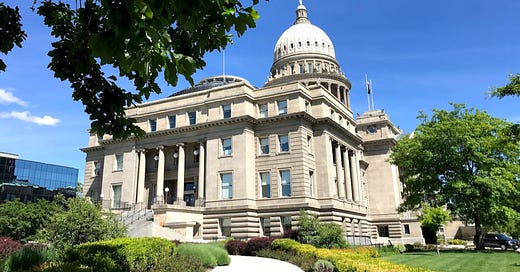Not so long ago, a group of legislators made a pledge — to each other and to their constituents — that they’d never vote for what they considered to be excessive government spending. So each and every time a budget bill that spent too much came up for a vote, they cast their votes in opposition.
Their actions were met with jeers. The media dismissed them as hardliners. Their colleagues said they were positioning themselves to lose in the next election. But they stood firm.
This is not a story from the 2025 session of the Idaho Legislature. It’s actually one from 2001. That year, the state of Idaho was sitting on a hefty budget surplus for the time — about $330 million. Lawmakers and Gov. Dirk Kempthorne wanted to spend the surplus, but they also wanted to cut taxes.
In the end, the big spenders got what they wanted — most of the money going into government agencies and programs — and the tax cutters were able to return just $100 million to Idahoans. But conservatives were delighted with the result.
In those days, budget bills very rarely failed on the floor of the House or Senate. None failed that year, but the coalition of conservative legislators was able to have enough support to have changes (meaning a decrease in the increase of spending) made to the proposed budget for the Department of Health and Welfare.
Still, the excessive spending demanded by Kempthorne and green-lighted by the Republican-controlled Legislature set the stage for an austere 2002 legislative session and 2003’s tax hikes, as the state government had to navigate an economy that was already sketchy and rocked by the Sept. 11, 2001, terrorist attacks.
And what ever became of that coalition of legislators? To my knowledge, no one lost an election for their efforts. In fact, their leader was a farmer from Star named Mike Moyle, in his second term. Of the 2001 session, he told the Idaho Statesman then, “My biggest regret is that we failed to stop the growth of government.”
That year, the state general fund budget grew by more than 11% to slightly more than $2 billion, or about $3.6 billion in today’s dollars. In the 2025 legislative session, lawmakers approved a $5.6 billion budget, 5.7% above the previous year (although it is important to note that in the last 24 years, the Legislature and the governor’s office have become pretty clever at hiding spending increases by transferring spending from the general fund and through so-called continuous appropriations that are no longer subject to legislative approval, so it is not an apples-to-apples comparison).
In 2001, the total budget for all of state government was about $4 billion, ($7.2 billion in today’s dollars). Today, Idaho’s total government budget is about $14 billion.
Earlier this year, during a debate in the House of Representatives on an appropriations bill, Rep. Heather Scott asked freshman Rep. Faye Thompson about the legislators —the Gang of 8 — who had pledged to vote against spending increases above 1.2%.
Presiding over the exchange, Moyle, now House Speaker and transformed from the wet-behind-the-ears legislator he was two decades ago, acted somewhat incredulous to the idea of a group of legislators making a pledge and voting in unison on budgets. Yet it was he who led a much larger group two decades ago, with a much less ambitious objective to oppose budgets with 6% increases in spending.
I have just a bit more to say about Moyle and Idaho’s Gang of Eight legislators, for paid subscribers, below:
Keep reading with a 7-day free trial
Subscribe to Level Up Humanity to keep reading this post and get 7 days of free access to the full post archives.




